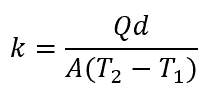Thermal conductivity is a measure of a material’s ability to transfer heat via conduction— that is, the higher the thermal conductivity, the faster the rate of heat transfer is, and vice versa.

In general, plastics are considered to be poor conductors of heat; however, the desire for lighter and more versatile thermal conductors has driven the development of new kinds of plastics that are thermally conductive. This article discusses and compares the thermal conductivity of the different types of plastics and tackles how plastic behaves as a heat conductor.
Thermal Conductivity Of Plastics
Plastics are generally considered to be poor thermal conductors.
In solid materials, thermal conduction happens through the collision of microscopic particles like atoms and electrons. In this process, the movement of heat is divided into two components:

Elevate Your Engineering With Excel
Advance in Excel with engineering-focused training that equips you with the skills to streamline projects and accelerate your career.
- Heat transfer via freely moving valence electrons
- Heat transfer via lattice vibrations
For plastics, heat conduction primarily happens only via lattice vibrations. This is because plastics are made up of covalently bonded polymeric chains whose electrons are closely bonded with the parent atoms, thus, no valence electrons exist.
In addition, unlike metals that have a lattice crystalline structure, the molecular structure of plastics typically contains amorphous areas that are disordered and not well-packed. Hence, the vibration of atoms is not uniformly transmitted across the material and a huge portion of the heat passing through is absorbed, instead of transmitted.
All of these factors contribute to the poor heat conductivity performance of plastics.
To show the difference in magnitude, the table below lists some of the most common materials together with their thermal conductivity values, including that of plastic.
Thermal Conductivity Of Plastics Vs Metals
A good way to better understand the thermal conductivity of plastics is to compare them with metals. As shown in the table above, the thermal conductivity of polymers is far lower than metals like copper, aluminum, and carbon steel.
While plastics only conduct heat through lattice vibrations, metals utilize both lattice vibrations and valence electrons to facilitate heat transfer. As a result, metals are generally better heat conductors than plastics.
Thermally Conductive Plastics
Their heat-conducting capability has allowed metals to dominate the heat sink market all this time. However, as industries move towards more complex, light, and compact technologies, the demand for more versatile heat conductors has been growing. Hence, thermally conductive plastics have been developed.
Thermally conductive plastics, also called filled polymers, are a breed of materials that combine the versatility and lightness of plastics with the thermal conductivity of metals. These are formed by combining plastic resins like polyphenylene sulfide, polybutylene succinate, polycarbonate, and polypropylene with additives, like graphite and graphene, to boost thermal conductivity.
While the thermal conductivity of unfilled polymers only hovers around 0.2 W/m-K, commercially available filled polymers can have thermal conductivity values ranging from 1 up to 100 W/m-K. This makes them a good metal alternative in heat sink applications like in custom-molded circuit boards and tubing for heat exchangers in corrosive environments where the use of metals can pose significant disadvantages.
Filled polymers were developed not to replace metals but rather to broaden the opportunities for thermal management. It was found that in many heat transfer applications, it is actually convection that limits the transfer rate— not conduction. Hence, using heat sink materials with enormous thermal conductivities may not be practical if convection cannot keep up.
In these types of applications, it may be more reasonable to use filled polymers instead of metals, especially if the application requires the material to be lightweight and moldable. However, in applications where conductivity is the limiting factor, it may be necessary to use metals.
It is important to note that it is only not the thermal conductivity that additives can enhance— they can also affect strength, density, friction, stiffness, and thermal expansion properties, among others. In addition, the combined thermal conductivity of a filled polymer does not only depend on the intrinsic conductivities of the plastic resin and additive used. Factors like shape and aspect ratio, volume loading, packing and orientation, and bonding also play a huge role in its final value.
Measuring The Thermal Conductivity Of Plastics
The standards used to experimentally measure the thermal conductivity of a plastic sample are ASTM C177 and ISO 8302. Both of which are standard test methods for obtaining the steady-state heat flux and thermal transmission properties using a guarded hot-plate apparatus.

In a guarded hot-plate apparatus, a solid plastic sample is placed between two plates with different temperatures. One plate is heated while the other is either cooled or heated at a lesser intensity. Then, the temperature of the plates is monitored until a steady-state condition is reached.
Using the steady-state parameters, the thermal conductivity is obtained using the following formula:

Where:
- k = thermal conductivity [W/m-K]
- Q = heat passed through the sample [W]
- d = thickness of the sample or the distance between the two plates [m]
- A = cross-sectional area of the sample [m2]
- T2 = steady-state temperature on the hotter side [K]
- T1 = steady-state temperature on the colder side [K]
It is important to note that thermal conductivity is not only dependent on material composition. It is also affected by density, moisture content, and ambient temperature. In general, as the density, moisture, and temperature increase, the thermal conductivity also increases.
Comparing The Thermal Conductivities Of Plastics
Plastics are a broad family of polymeric materials with different thermal properties. Because of the large variations in their compositions, it is notoriously hard to accurately determine the values of their thermal conductivity. Hence, for many plastic materials, handbooks normally provide a range of thermal conductivity values, instead of a single value.
In general, plastics can be divided into four categories based on the magnitude of thermal conductivity: very low, low, moderately high, and high conductivity plastics.
“Very low conductivity” plastics are those whose thermal conductivity falls below 0.1 W/m-K. These include unfilled polyaramide and polyimide filled with hollow microspheres. These hollow microspheres can be made of glass, polymer, ceramic, or carbon.
“Low conductivity” plastics are those whose thermal conductivity ranges between 0.1 to 0.5 W/m-K. These include most unfilled plastics like epoxy, PVC, HDPE, and phenolics.
“Moderately high conductivity” plastics are those whose thermal conductivity ranges between 0.5 to 10 W/m-K. These include polyimide with 40% graphite, rubber filled with aluminum flakes, and commercially available electrically non-conductive plastics.
“High conductivity” plastics are those whose thermal conductivity ranges between 10 to 600 W/m-K. These include filled plastics that use high-aspect-ratio fillers like metalized glass and graphite fibers, high-performance carbon fibers, and carbon nanotubes. Unfortunately, there is a limit due to processibility, and price increases significantly at very high thermal conductivities.
The thermal conductivity values of some of the most common filled and unfilled plastics are listed in the tables below.
Best Thermal Conductivity Plastics
Based on the tables above, epoxy filled with single-walled carbon nanotubes has the best thermal conductivity value at 600 W/m-K. Among unfilled plastics, it is high-density polyethylene that has the highest thermal conductivity ranging from 0.45 to 0.52 W/m-K.
Lowest Thermal Conductivity Plastics
Based on the tables above, polymers filled with microspheres have the lowest thermal conductivity ranging from 0.03 to 0.12 W/m-K. Among unfilled plastics, it is polyaramide that has the lowest thermal conductivity ranging from 0.04 to 0.13 W/m-K.
